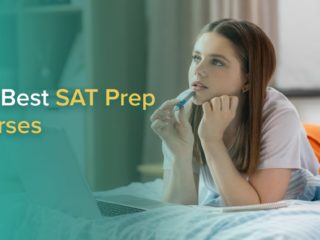| Getting your Trinity Audio player ready... |
Last Updated on September 30, 2024
Preparing for the SAT is a massive undertaking, so it’s important to have a sound study strategy to help you achieve your desired SAT score. The good news is that with a structured and coordinated approach, you will be miles closer to acing the SAT.
This article will walk you through all of the components that make up the two critical phases of SAT preparation: the learning phase and the practice-test phase. You’ll also get 7 expert strategies to implement during those two phases in order to give yourself the best chance at SAT success.
So, if you’ve asked yourself, “What is the best way to study for the SAT?,” this two-phase test prep approach is it!
Here are the topics we’ll discuss:
- The Two Main Phases of SAT Preparation
- Phase 1: The Learning Phase
- Phase 2: The Practice-Test Phase
- In Conclusion
Let’s define the two phases and why it’s critical to complete them in order.
The Two Main Phases of SAT Preparation
Your SAT preparation should consist of two distinct phases: the learning phase and the practice-test phase. The first phase (learning) consists of learning SAT math and EBRW topics through topical study and practice. The second phase (practice) involves practicing your math and EBRW skills by taking full-length practice exams.
It is critical not to take your practice exams prematurely. Except for an initial practice test to establish your baseline score, the data from practice tests will be meaningless unless you have fully completed the learning phase of your preparation. For example, let’s say you take a practice exam before learning Functions, and you answer four Function questions incorrectly on the exam. What exactly does that data indicate? What you already knew: you’re not on top of your game with Functions. That’s hardly surprising, given that you haven’t studied that topic yet!
TTP PRO TIP:
During the learning portion of your SAT preparation, avoid taking practice tests.
Let’s discuss the learning phase in further detail.
Phase 1: The Learning Phase
You’ve researched your target colleges and set your score goal. You’ve finished your first full-length, official SAT practice exam under realistic testing conditions to establish your target score. Finally, you’re ready to start preparing for the SAT!
You might be wondering, “Now what?” First, keep in mind that SAT math and EBRW questions span a wide range of topics. It’s impossible to predict which specific concepts will appear on any SAT. Thus, studying SAT topics at random, without any order or logical progression, is not a productive or efficient study approach.
A topical approach is a highly successful way to master the numerous topics and concepts you’ll encounter during the first phase of your SAT preparation. Let’s take a closer look at this method.
Strategy #1: Use a Topic-by-Topic Approach
Following a topical study plan is an efficient and effective way to learn SAT math, Reading, Writing and Language. If you are wondering why, think about this:
Do you think it would be beneficial to answer random SAT questions by first doing a random SAT Reading question. Then a random Writing and Language question, and then another random Reading question?
In math, would jumping from exponent questions to quadratic questions to statistics questions before knowing those concepts be beneficial?
The answer to both of these questions is NO! You won’t be able to get traction in any one math or EBRW topic if you jump around randomly between topics. You’ll feel like you’re treading water instead of progressing and improving your skills.
So, the structure of your SAT study plan should be to learn one topic at a time and then answer many questions on that topic before moving on to the next. Start with the fundamentals and work your way up to more advanced concepts using this strategy.
TTP PRO TIP:
Don’t jump around from topic to topic in your SAT studying. Focus your attention on one topic at a time until you master it, starting with the fundamentals.
An Example of a Topical Study Plan
For example, the TTP SAT Study Plan specifies which chapters and topics students learn and in what order. As you encounter each topic, you answer 2 to 3 example questions, and then finally, after you complete all topics in the chapter, you complete a series of easy, medium, and hard chapter tests. Their purpose is to help you affirm that you have mastered the material. (Or, if you haven’t, you’ll get instant feedback about which topics still need work.)
Detailed metrics are offered after each chapter exam. Students can quickly review the material from the lessons that gave them issues during a chapter test. They use this information to improve any weak areas before moving on to the next test.
Following a structured and topical strategy maximizes efficiency because you can always see what you’ve learned and what you still need to learn. Furthermore, if you comprehend each topic before tackling a large number of practice questions on that topic, your SAT practice becomes a tool for validating that you understand what you’ve studied.
It’s also important to remember that, unless you follow a structured study plan, finding and correcting your SAT knowledge gaps can feel like a game of whack-a-mole. In other words, you fix one knowledge gap only to find another one that takes its place.
TTP PRO TIP:
To make your SAT prep more structured, efficient, and effective, take a topic-by-topic approach.
Now that you have a good overview of how to structure your study plan, let’s talk about some additional study strategies you should employ to master each new SAT topic.
Strategy #2: Alternate Between Math and EBRW Study
While some separation of math and EBRW study is beneficial, I do not recommend studying SAT math and Evidence-Based Reading and Writing during entirely different periods of your preparation. For example, I wouldn’t recommend studying only SAT math for the first two months of preparation, and then only SAT EBRW for the next two months. Having such wide gaps in time since you studied certain concepts will make it more difficult to remember what you’ve learned. Consider how much math knowledge you’d lose if you skipped two months of math studying.
While we don’t want to forget what we’ve learned, it’s also necessary to give our minds a break while dealing with many concepts in a single topic. Consider what it would be like to spend a whole semester taking only math classes. Doesn’t that sound exhausting? Even if you enjoy math, spending hours every day studying it will almost certainly result in boredom and could even lead to a distaste for math, right?
Thus, alternating math and EBRW topics within your study plan is an excellent idea. For example, let’s imagine a student using the TTP course spent 12 days going over all of the lessons and chapter tests on Linear Equations. The chapter on Subject-Verb Agreement in Writing and Language would be presented as the next task. Following that chapter, a return to math would be next, perhaps Roots and Exponents.
This method of learning allows students to take the time and space between topics so they can fully absorb what they’ve studied. They’re also more likely to remain interested in what they are learning.
TTP PRO TIP:
Alternate between math and EBRW study, so you can fully absorb what you’ve learned, remain engaged in your learning, and make sure knowledge doesn’t slip away.
Strategy #3: Take Notes While Learning
Taking notes as you learn new topics is critical. Students frequently read or watch videos about topics without doing anything to reinforce what they’ve learned. Learning through passive activity is ineffective.
Taking notes as you cover new concepts is one approach to becoming an active participant in your learning. Putting a concept into your own words also helps you fully understand that concept. So, be sure to engage your brain by taking meaningful notes on key concepts when reading a lesson or viewing a video.
In addition, taking notes can provide you with something to review after you complete a topic. Those notes can then be turned into flashcards, an important study tool that we’ll discuss next.
TTP PRO TIP:
Taking notes makes you a more active learner and provides you with reference material for later review.
Strategy #4: Use Flashcards to Study Strategically
Making and reviewing flashcards that highlight key topics is an excellent way to streamline your SAT studying. Make flashcards with essential concepts and formulas from your notes. Those flashcards will allow you to review what you’ve learned and ensure that no knowledge is lost.
Flashcards are also great because you can use them anytime and anywhere. For example, if you ride the bus to school, you can study your flashcards. Take out your flashcards and give yourself a 2-minute quiz as you wait for the bus. You’ll find multiple opportunities to fit in “quick-hit” flashcard study sessions throughout your day, and believe me when I say they add up! By fitting in five minutes here and ten minutes there, you can add an effortless 20 minutes every day to your regular study time. So, you’d get an extra 2 hours and 20 minutes of SAT studying in a week!
Traditional or Digital Flashcards Can Be Used
Traditional paper flashcards are preferred by some students, while others prefer digital flashcards. Make sure to review your flashcards as often as possible, regardless of your chosen format. To add a new difficulty level, shuffle the deck or randomize your cards before each use. If you reorder the cards each time you study them, your brain will have to work harder to recall the material, and your knowledge retention will improve.
Keep in mind that the number of flashcards you have will increase as you progress through your SAT study plan. Therefore, divide your cards into two piles to make flashcard studying more efficient: one for topics you’ve mastered and another for concepts you haven’t. You’ll naturally want to check the “not mastered” pile more frequently than the “mastered” pile. However, as we’ll see next, you won’t want to forget what you’ve already learned, so check your “mastered” pile regularly.
TTP PRO TIP:
Make your flashcard review more challenging by shuffling the deck before each use of your flashcards.
Strategy #5: Take a Look Back at What You’ve Learned
As you progress through the learning phase of your SAT study plan, you must frequently revisit SAT topics you’ve already learned. But, as we’ve already discussed, don’t stray so far from a topic that you forget about it. Because there is so much information to learn for the SAT, you risk losing knowledge as you progress through your studies if you don’t review past topics frequently.
Consider learning a foreign language: even if you become proficient, it won’t take long to forget words if you don’t regularly hear and speak the language. Take the same approach to SAT preparation. It’s not very likely that you’ll be able to study a topic only once during your preparation and still remember it on test day.
So, as part of your SAT study plan, include periodic review tests on previously studied topics. This should be done in addition to fitting in flashcard review whenever possible to refresh key topics.
It’s not very likely that you’ll be able to study a topic only once during your preparation and still remember it on test day.
How TTP Students Review Past Topics
For example, when students progress from one math or EBRW chapter to the next in the TTP course, they start with a review quiz of 10 questions based on several of the previous chapters they’ve studied. These quizzes allow students to refresh themselves on what they’ve studied. As a result, as new information is learned, important concepts are less likely to be forgotten.
Students are also tested on past topics with periodic mixed-topic review quizzes. These quizzes are similar to what students would encounter in the math and EBRW sections of the real SAT because they cover multiple topics. Additionally, our mixed sets are carefully constructed so that our students never waste time on concepts they haven’t yet learned. Ultimately, students never go too far in their study plans without seeing older topics.
For example, if a student completes the Exponents and Roots chapter on day 75, it’s not as if she will not face another Exponents and Roots question until day 150. On days 85, 100, 127, and so on, she may encounter Exponents questions in mixed-problem review tests.
The TTP study plan also contains larger, 20-question review tests that cover material from previous chapters, in addition to the review quizzes (shown below). These assessments allow for both strategic review of previously learned topics and timed practice.
TTP PRO TIP:
Returning to previously learned SAT topics at frequent, strategic intervals trains your brain to recognize the importance of the information, improving your chances of recalling it on exam day.
Reviewing your error log is another opportunity to evaluate older topics on a frequent basis. Let’s talk about that strategy now.
Strategy #6: Examine Your Error Log Weekly
While it’s critical to go over every SAT question you answer incorrectly, it’s also crucial to keep track of those incorrect answers and why you answered them incorrectly. However, simply keeping track of your errors and going through them at random is not an effective approach to avoid making the same mistakes again.
For example, the TTP course provides students with an error log that they should evaluate once a week. Our students reread the solutions to the questions they answered incorrectly from past chapters. They then return to their study materials or notes to review any concepts they struggled with.
A weekly check of your error log ensures that you correct mistakes and address knowledge gaps without letting them linger. These regular checks keep the gaps from widening and prevent bad habits from becoming ingrained.
Furthermore, doing a weekly “check-in” with your error log ensures that you’re never faced with an overwhelming number of topics that need to be improved. For example, consider how much work you’d have to put in if you studied and practiced for the SAT for three months before checking your error log.
TTP PRO TIP:
Doing a weekly “check-in” with your error log ensures that knowledge gaps and poor habits don’t fester.
The learning part of your preparation will be complete once you’ve thoroughly studied and practiced each SAT topic, revisited previous topics in mixed sets, and reviewed and fixed your weak areas. At that point, you’ll be ready to go on to the second (and final) phase of your SAT preparation: taking full-length practice tests.
Phase 2: The Practice-Test Phase
You will take the remaining seven full-length, official SAT practice exams in the final portion of your study plan. (Note that the College Board website offers eight practice examinations. However, you will already have taken one to get your baseline SAT score at the start of your study plan.)
Let’s talk about how to complete the remaining practice tests.
Strategy #7: Spread Out Your Practice Tests
Take the seven remaining full-length practice tests, available at the College Board website. They’ll help you get used to taking the SAT, build stamina, fine-tune your pacing, see how close you are to your target score, and pinpoint any lingering weak areas. Note that this technique of taking official SAT practice exams to help with any remaining weak areas only works after you’ve completed the learning phase.
Make sure your practice exams are spaced apart, with around seven days between them. You don’t want to find yourself in a situation in which you have to complete all seven practice tests in just two weeks. You’ll have more time between practice tests to review and correct your weak areas if you spread the tests out. You’ll also get a few days between tests to clear your head, which is essential for peak performance.
TTP PRO TIP:
Make sure to space out each of your practice exams by about 7 days.
Of course, if you’re not achieving your target SAT score on full-length practice exams, you should consider whether you need more SAT prep time. Remember, there is no “standard” time frame for finishing SAT preparation because every student learns and develops skills at a different pace. Additionally, the greater the gap between your baseline and target scores, the more time you’ll need to prepare for the SAT effectively.
TTP PRO TIP:
If you’re not achieving your target SAT score on full-length practice exams, consider whether you need more SAT prep time.
In Conclusion
This article has covered the two phases of SAT preparation: the learning phase and the practice-test phase. We presented 7 strategies, 6 to utilize during the learning phase and 1 strategy to utilize in the practice-test phase.
- Phase 1: The Learning Phase
- Strategy #1: Use a Topic-by-Topic Approach
- Strategy #2: Alternate Between Math and EBRW Study
- Strategy #3: Take Notes While Learning
- Strategy #4: Use Flashcards to Study Strategically
- Strategy #5: Take a Look Back at What You’ve Learned
- Strategy #6: Examine Your Error Log Weekly
- Phase 2: The Practice-Test Phase
- Strategy #7: Spread Out Your Practice Tests
If you follow the advice in this article and employ these 7 SAT strategies, your studying will be efficient and effective, leading to your best score possible!
Happy Studying!



